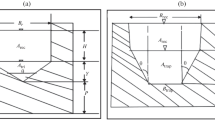Abstract
The under-pressure-induced-ambient flow velocity and the bending phenomenon of the horizontal buoyant jets on a Rosette-type riser with four ports were observed by conducting the hydraulic experiments over a certain range considering the initial moment um and initial buoyancy. The measurement accuracy associated with the PIV system was verified. The velocity of the ambient flows into the inner side of the surrounding buoyant jets increased initially, and then decreased with the increase of the densimetric Froude number. The trajectories for low densimetric Froude numbers tended to rise up without strong bending whereas high densimetric Froude numbers resulted in more strongly bending trajectory and then led to the release of the bending trajectory with the increase of the densimetric Froude number. The low bending height resulted from the strongly bending buoyant jet. The experimental results revealed that the trajectories bend to the inner side with the increase of the ambient flow velocity.
Similar content being viewed by others
References
Adrian, R.J. (1991). “Particle-imaging techniques for experimental fluid mechanics.”Annu. Rev., Journal of Fluid Mechanics, Vol. 23, pp. 261–304.
Akar, P.J. and Jirka, G.H. (1991).CORMIX2: An Expert System for Hydrodynamic Mixing Zone Analysis of Conventional and Toxic Submerged Multiport Diffuser Discharges, Technical Report, DeFrees Hydraulics Laboratory, School of Civil and Environmental Engineering, Cornell University, Ithaca, New York.
Brooks, N.H. (1972).Dispersion in Hydrologic and Coastal Environments. California Institute of Technology Technical Report KH-R-29, W. M. Keck Laboratory of Hydraulics and Water Resources Division of Engineering and Applied Science, Pasadena, California.
Cederwall, K. (1968).Hydraulics of Marine Wastewater Disposal, Hydraulic Division Report No. 42, Chalmers Institute of Technology, Goteborg, Sweden.
Davidson, M.J. (1989). “The behavior of single and multiple, horizontally discharged, buoyant flows in a non-turbulent coflowing ambient fluid.” Ph. D. thesis. Dept. of Civil Engineering, University of Canterbury, Christchurch, New Zealand.
Fischer, H.B., Imberger, J., List, E.J., Koh, R.C.Y., and Brooks, N.H. (1979).Mixing in Inland and Coastal Water. Academic Press, New York.
Hongwei, W. (2000). “Investigations of buoyant jet discharges using Digital Particle Velocimetry (DPIV) and Planar Laser Induced Fluorescence (DPIV).” Ph. D. thesis, School of Civil and Structural Engineering, Nanyang Technological University, Singapore.
Jirka, G.H. and Akar, P.J. (1991). “Hydrodynamic classification of submerged multiport-diffuser discharges.”Journal of Hydraulic Engineering, ASCE, Vol. 117, No. 9, pp. 1113–1128.
Kwon, S.J. and Seo, I.W. (2005). “Reynolds number effects on the behavior of a non-buoyant round jet.”Experiments in Fluids, Vol. 38, No. 6, pp. 801–812.
Lee, J.H.W. (1989). “Note on Ayoub's data of horizontal round buoyant jet in current.”Journal of Hydraulic Engineering, ASCE, Vol. 115, No. 7, pp. 969–975.
Lyu, S.W. (2003). “Behavior of merging buoyant jets discharged from uni-directional diffuser.” Ph. D. thesis, School of Civil, Urban and Geosystem Engineering, Seoul National University, Seoul, Korea.
Park, Y.S. (2001). “Experimental study of near field characteristics of the round turbulent buoyant Jets.” M. S. thesis, School of Civil, Urban and Geosystem Engineering, Seoul National University, Seoul, Korea.
Roberts, P.J.W. (1977).Dispersion of Buoyant Waste Water Discharged from Outfall Diffusers of Finite Length, California Institute of Technology Technical Report KH-R-35, W. M. Keck Laboratory of Hydraulics and Water Resources Division of Engineering and Applied Science, Pasadena, California.
Roberts, P.J.W. and Snyder, W.H. (1993a). “Hydraulic model study for Boston outfall. I: riser configuration.”Journal of Hydraulic Engineering, ASCE, Vol. 119, No. 9, pp. 970–987.
Roberts, P.J.W. and Snyder, W.H. (1993b). “Hydraulic model study for Boston outptfall. II: environmental performance.”Journal of Hydraulic Engineering, ASCE, Vol. 119, No. 9, pp. 988–1002.
Seo, I.W., Kwon, S.J., and Yeo, H.K. (2004). “Merging characteristics of buoyant discharges from Rosette-tyype dffusers in shallow Water.”Journal of Civil Engineering, KSCE, Vol. 8, No. 6, pp. 679–688.
White, F.M. (1979).Fluid Mechanics. McGraw-Hill. New York.
Wright, S.J. (1984). “Buoyant jets in density-stratified crossflow.”Journal of Hydraulic Engineering, ASCE, Vol. 110, No. 5, pp. 643–656.
Author information
Authors and Affiliations
Corresponding author
Rights and permissions
About this article
Cite this article
Kwon, S.J., Seo, I.W. Experimental investigation of wastewater discharges from a Rosette-type riser using PIV. KSCE J Civ Eng 9, 355–362 (2005). https://doi.org/10.1007/BF02830626
Received:
Accepted:
Issue Date:
DOI: https://doi.org/10.1007/BF02830626




